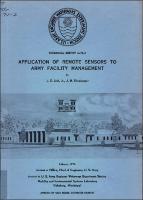Please use this identifier to cite or link to this item:
https://hdl.handle.net/11681/34581Full metadata record
| DC Field | Value | Language |
|---|---|---|
| dc.contributor.author | Link, Lewis E. (Lewis Edward), 1946- | - |
| dc.contributor.author | Shamburger, J. H. (John H.) | - |
| dc.contributor.author | Mobility and Environmental Systems Laboratory (U.S.) | - |
| dc.date.accessioned | 2019-11-12T18:40:58Z | - |
| dc.date.available | 2019-11-12T18:40:58Z | - |
| dc.date.issued | 1974-02 | - |
| dc.identifier.govdoc | Technical Report M-74-2 | - |
| dc.identifier.uri | https://hdl.handle.net/11681/34581 | - |
| dc.description | Technical Report | en_US |
| dc.description.abstract | Authorization for the work reported herein is contained in Intra- Army Order for Reimbursable Services dated 30 March 1972 from the Office, Chief of Engineers, to the U. S. Army Engineer Waterways Experiment Station (WES). The work was in support of Project 4A662707A890, "Extraterrestrial Research," for the Advanced Technology Branch, Engineering Division, Military Construction Directorate. The study was conducted under the general supervision of Messrs. W. G. Shockley, Chief of the Mobility and Environmental Systems Laboratory (MESL), and W. E. Grabau, Chief of the Environmental Systems Division (ESD), MESL, and under the direct supervision of Messrs. B. O. Benn, Chief of the Environmental Research Branch (ERB), ESD, and L. E. Link, Jr., ERB, Project Manager. This report was prepared by Messrs. Link and J. H. Shamburger, Chief of the Terrestrial Sciences Branch, Engineering Geology Division (EGD), Soils and Pavements Laboratory, WES. Acknowledgment is made to Messrs. J. D. Broughton, W. K. Dornbusch, Jr., J. R. May, and H.K. Woods of the EGD for interpreting the aerial photography and mapping the environmental factors in this study. Directors of WES during this program and the preparation and publication of this report were BG E. D. Peixotto, CE, and COL G. H. Hilt, CE. Technical Director was Mr. F. R. Brown. | en_US |
| dc.description.sponsorship | Sponsored by Office, Chief of Engineers, U. S. Army | en_US |
| dc.description.tableofcontents | FOREWORD. CONVERSION FACTORS, METRIC TO BRITISH UNITS OF MEASUREMENT SUMMARY PART I: INTRODUCTION Background Purpose Scope PART II: DEFINITION OF DATA REQUIREMENTS Approach . . . Data Requirements PART III: APPLICABILITY OF REMOTE SENSORS Informational Content of Remote Imagery Acquisition of Required Data . . . . . . PART IV: ENVIRONMENTAL MAPPING FROM REMOTE SENSOR PRODUCTS Factors and Factor Classes Selected for Mapping Acquisition of Aerial Photography Mapping Procedures . ·. . . . . . . . Presentation of Products . . . . . . PART V: DISCUSSION OF PROTOTYPE PRODUCTS Feasibility of Detecting Change Discussion of Environmental Base Lines PART VI: FUWRE RESEARCH REQUIREMENTS PART VII: CONCLUSIONS AND RECOMMENDATIONS Conclusions Recommendations SELECTED BIBLIOGRAPHY TABLES 1-8 PLATES 1-4 | - |
| dc.format.extent | 160 pages / 62.10Mb | - |
| dc.format.medium | PDF/A | - |
| dc.language.iso | en_US | en_US |
| dc.publisher | U.S. Army Engineer Waterways Experiment Station | en_US |
| dc.relation.ispartofseries | Technical Report (U.S. Army Engineer Waterways Experiment Station);no. M-74-2 | - |
| dc.rights | Approved for public release; distribution is unlimited | - |
| dc.source | The ERDC Library created this digital resource using one or more of the following: Zeta TS-0995, Zeutcehl OS 12000, HP HD Pro 42-in. map scanner, Epson flatbed | - |
| dc.subject | Remote sensing | en_US |
| dc.subject | Environmental protection--Research | en_US |
| dc.subject | Military bases | en_US |
| dc.title | Application of Remote Sensors to Army Facility Management | en_US |
| dc.type | Report | - |
| Appears in Collections: | Technical Report | |
Files in This Item:
| File | Description | Size | Format | |
|---|---|---|---|---|
| Technical Report M-74-2.pdf | 63.6 MB | Adobe PDF |  View/Open |